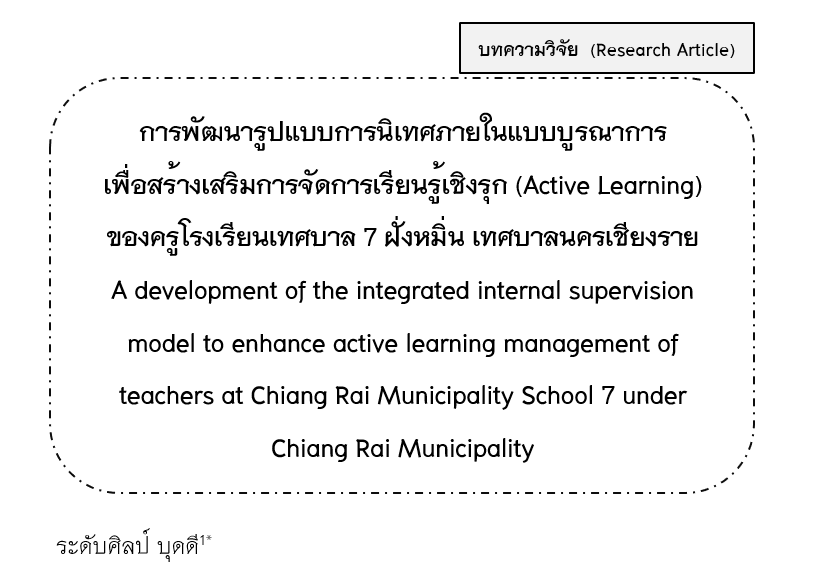A development of the integrated internal supervision model to enhance active learning management of teachers at Chiang Rai Municipality School 7 under Chiang Rai Municipality
Keywords:
Supervision model, Integrated internal supervision, Active learning managementAbstract
This research aimed to 1) study the demographic information in order to develop the integrated internal supervision model to enhance active learning management 2) construct and validate quality of the integrated internal supervision model to enhance active learning management 3) study the result of using the integrated internal supervision model to enhance active learning management and 4) assess the opinion of teachers under supervision towards the integrated internal supervision model to enhance active learning management. The study was sectioned into 4 stages. The samples were 30 teachers. The instruments were an assessment form, an interview form and a multiple-choice test. The statistics for data analysis were mean, standard deviation, content analysis and t-test dependent.
The results showed that
- The integrated internal supervision model was a supervision process which focused observing teachers’ behavior in teaching management for giving advice and feedback, improving and developing teaching quality with an emphasis on active learning management. This model was derived from an integration of Clinical Supervision, Mentoring Supervision and Cooperative Professional Development. The supervisors and teachers under supervision co-discussed the design of learning management plan, teaching observation, deployment of teaching, and sharing teaching feedback until the teaching goal was successfully achieved.
- The construction and quality validation of the integrated internal supervision model to enhance active learning management revealed that the model consisted 6 components i.e. 1) Principle 2) Objective 3) Content 4) Supervision Process 5) Evaluation 6) Success condition. The supervision process comprised 4 steps i.e. 1) D: Directional Planning 2) S: Supervisory Management 3) L: Learning and Development 4) D: Dynamics. The results indicated that the integrated internal supervision model and the handbook, in overall, were rated at the high level. Teachers showed knowledge, understanding, ability to write active learning lesson plan and positive attitude towards active learning management.
- The pilot study on deployment of integrated supervision model to enhance active learning management indicated that teachers showed higher knowledge and understanding of active learning management after participating in the development program at the statistical level of .05. Their ability to write the active learning lesson plan for reinforcement of active learning management, in overall, was rated at the highest level. The attitude towards active learning management, in overall, was also rated at the high level.
- The teachers’ opinion towards the integrated supervision model to enhance active learning management, in overall, was rated at the highest satisfied level.
References
ฝ่ายวิชาการ. (2562). พระราชบัญญัติการศึกษาแห่งชาติ พ.ศ. 2542 แก้ไขเพิ่มเติมถึง (ฉบับที่ 4) พ.ศ. 2562. กรุงเทพฯ: สำนักพิมพ์เดอะบุคส์จำกัด.
พิมพันธ์ เดชะคุปต์ และพเยาว์ ยินดีสุข. (2561). การเรียนรู้เชิงรุกแบบรวมพลังกับ PLC เพื่อการพัฒนา. กรุงเทพฯ: สำนักพิมพ์แห่งจุฬาลงกรณ์มหาวิทยาลัย.
พิสณุ ฟองศรี. (2553). เทคนิควิธีการประเมินโครงการ (พิมพ์ครั้งที่ 7). กรุงเทพฯ: ด่านสุทธาการพิมพ์.
มนสิช สิทธิสมบูรณ์. (2565). กลยุทธ์การจัดการเรียนรู้เชิงรุก. พระนครศรีอยุธยา: โรงพิมพ์มหาจุฬาลงกรณ์ราชวิทยาลัย.
โรงเรียนเทศบาล 7 ฝั่งหมิ่น. (2564). การนิเทศภายในสถานศึกษาปีการศึกษา 2564. โรงเรียนเทศบาล 7 ฝั่งหมิ่น สำนักการศึกษา เทศบาลนครเชียงราย อำเภอเมือง จังหวัดเชียงราย.
โรงเรียนเทศบาล 7 ฝั่งหมิ่น. (2564). รายงานผลการประเมินตนเอง (Self Assessment Report) 2564. โรงเรียนเทศบาล 7 ฝั่งหมิ่น สำนักการศึกษา เทศบาลนครเชียงราย อำเภอเมือง จังหวัดเชียงราย.
วงศ์พันธ์ เวียงนนท์, สุวิมล โพธิ์กลิ่น และธิดารัตน์ จันทะหิน. (2564). การศึกษาสภาพปัจจุบันปัญหาและแนวทางการนิเทศภายในสถานศึกษา สำนักงานเขตพื้นที่มัธยมศึกษา เขต 28. วารสารวิทยาลัยบัณฑิตเอเชีย, 11(1), 197-199.
วัชรา เล่าเรียนดี, อรพิณ ศิริสัมพันธ์ และปรณัฐ กิจรุ่งเรือง. (2560). กลยุทธ์การจัดการเรียนรู้เพื่อพัฒนาการคิดและยกระดับคุณภาพการศึกษาสำหรับศตวรรษที่ 21. นครปฐม: เพชรเกษมพริ้นติ้ง กรุ๊ป.
ศุภลักษณ์ มีปาน. (2562). รูปแบบการนิเทศภายในสำหรับการจัดการเรียนร่วมในโรงเรียนสังกัดกรุงเทพมหานคร. (วิทยานิพนธ์ปรัชญาดุษฎีบัณฑิต สาขาวิชาการบริหารการศึกษา). กรุงเทพฯ: มหาวิทยาลัยนอร์ทกรุงเทพ.
สุกัญญา งามบรรจง. (2560). รูปแบบการจัดกระบวนการเรียนรู้เพื่อเสริมสร้างทักษะในศตวรรษที่ 21 ผ่านกิจกรรมลดเวลาเรียน เพิ่มเวลารู้. กรุงเทพฯ: สำนักงานคณะกรรมการการศึกษาขั้นพื้นฐาน กระทรวงศึกษาธิการ.
Acheson, K.A. & Gall, M.D. (1997). Techniques in the clinical supervision of teachers: preservice and in-service applications (4th edition). Longman Publishers, 10 Bank St., White Plains N.Y.
Beach, D.M. and Reinhartz, J. (2000). Supervision leadership: Focus on instruction. Boston: Allyn and Bacon.
Glatthorn, A.A. (1994). Differentiated supervision. Washington D.C.: Association for Supervision and Development.
Glickman, Carl D, Godon, Stephen P., & Rose-Gordon, Jovita M. (2016). Supervision and instruction leadership: A developmental approach. Boston: Allyn and Bacon. Inc.
Herzberg, Frederick. (2001). Work and the nature of man. New York: World.
Hudson, P., & Hudson, S. (2010). Mentor educators understanding of mentoring pre service primary teachers. International Journal of Learning, 17(2), 157-170.
Kyriacou Chris. (2007). Essential teaching skills. United Kingdom: Nelson.
Maslow's-Hierarchy-Of-Needs. (2009). ทฤษฎีความต้องการของ มาสโลว์. Retrieved June 24, 2022, from http://www.biz-development.com/HumanResources/3.18.
Nick, J.M. and et al., (2012). Best practices in academic mentoring: A model for excellence. Nursing Research and Practice.
Plook Teacher. (2562). การส่งเสริมการศึกษาไทยเพื่อรับมือกับยุค VUCA. สืบค้น 14 กรกฎาคม 2565, จาก https://www.trueplookpanya.com/education/content/76134.

Downloads
Published
How to Cite
Issue
Section
License
Copyright (c) 2023 Phayao University

This work is licensed under a Creative Commons Attribution-NonCommercial-NoDerivatives 4.0 International License.
ผู้นิพนธ์ต้องรับผิดชอบข้อความในบทนิพนธ์ของตน มหาวิทยาลัยพะเยาไม่จำเป็นต้องเห็นด้วยกับบทความที่ตีพิมพ์เสมอไป ผู้สนใจสามารถคัดลอก และนำไปใช้ได้ แต่จะต้องขออนุมัติเจ้าของ และได้รับการอนุมัติเป็นลายลักษณ์อักษรก่อน พร้อมกับมีการอ้างอิงและกล่าวคำขอบคุณให้ถูกต้องด้วย
The authors are themselves responsible for their contents. Signed articles may not always reflect the opinion of University of Phayao. The articles can be reproduced and reprinted, provided that permission is given by the authors and acknowledgement must be given.







